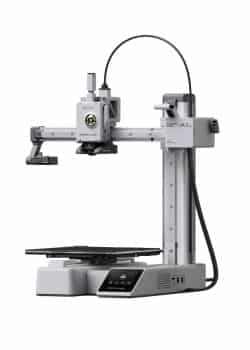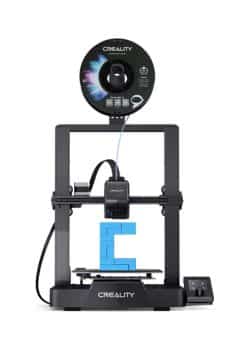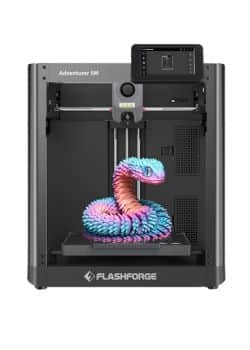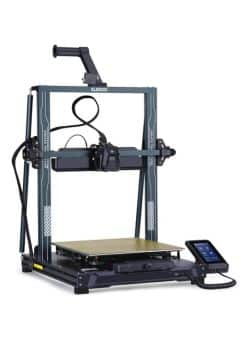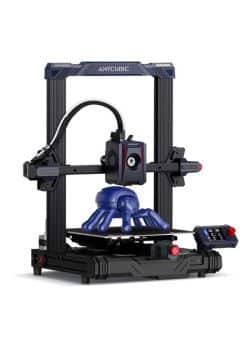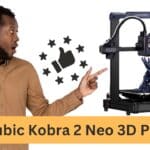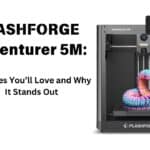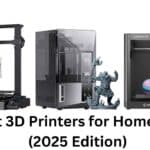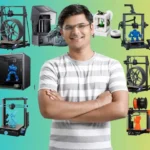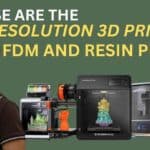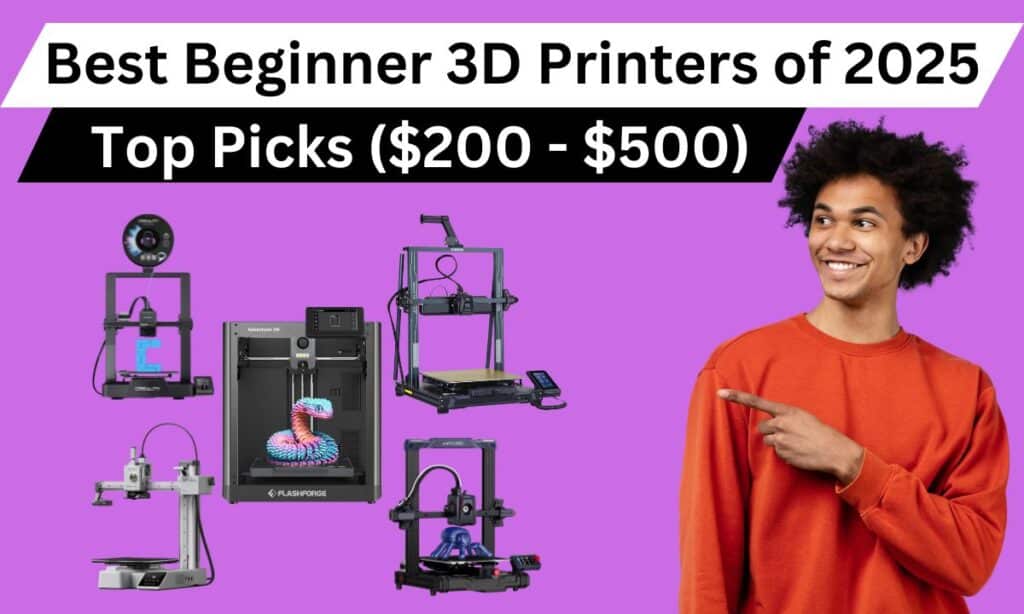
In 2025, Bambu Lab A1 Mini ($359) is the best beginner 3D printer for ease and speed. ELEGOO Neptune 4 Plus offers versatility; Creality Ender-3 V3 SE balances reliability.
Looking to dive into the world of 3D printing without breaking the bank? Our guide to the best beginner 3D printers of 2025, priced between $200 and $500, has you covered. With so many options available, how do you choose the right printer to match your needs and budget?
Affiliate Disclosure
We participate in Amazon affiliate programs, earning fees from qualifying purchases via links at no extra cost to you. It’s how we keep this blog rolling and my 3D printers buzzing with fresh filament for reviews like this one!
This article highlights 5 beginner-friendly 3D printers in the $200–$500 range. From precise print quality to user-friendly features, we’ve evaluated each option to ensure they’re perfect for hobbyists and newcomers alike. Expect insights from industry experts and hands-on reviews to make your decision effortless.
Ready to transform your ideas into tangible creations? These recommendations are just the beginning. Let’s explore the best options in detail and help you start your 3D printing journey confidently.
Related: Best 3D Printers For Every Budget 2025 (Under $100 to Over $1000)
Key Features to Look for in a Beginner 3D Printer
When selecting a beginner-friendly 3D printer, consider the following essential features:
- Preassembled or Easy-to-Assemble Design: Look for printers that come preassembled or require minimal setup to facilitate a quick start.
- User-Friendly Interface and Touchscreen Controls: A straightforward interface simplifies navigation through various settings, making it accessible for beginners.
- Reliable Customer Support and Warranty: Opt for brands known for excellent customer service and warranty options to ensure assistance when needed.
- Compatibility with Common Filaments: Ensure the printer supports widely used materials like PLA and PETG for versatile printing options.
- Essential Safety Features: Look for printers equipped with safety mechanisms such as auto-shutoff and enclosed designs to prevent accidents.
- Build Volume and Precision: A larger build volume accommodates more extensive projects, while precision guarantees high-quality prints.
5 Best Beginner 3D Printers of 2025
1. Bambu Lab A1 Mini
Key Features
- Price: $359
- AMS Lite: Enables multi-color printing, making it accessible for everyone.
- Plug-N-Play Design: Pre-assembled, pre-squared, and pre-tuned for easy setup in about 20 minutes.
- Full-Auto Calibration: Automatically calibrates Z-offset, bed-level, vibration resonance, and nozzle pressure for every print job.
- Auto Z-Offset: Measures the absolute Z-offset using the nozzle, eliminating the need for manual paper methods.
- Auto Vibration Calibration: Tunes both X and Y resonance before each print.
- Active Flow Rate Compensation: Utilizes sensors to measure pressure in the nozzle and adjusts flow rate accordingly.
- High-speed Precision: Capable of printing at speeds up to 500 mm/s with high-quality results.
- Intuitive UI: Simplified touchscreen interface makes it user-friendly.
- Quiet Operation: Active motor noise canceling keeps noise levels under 48 dB.
Pros and Cons
Pros
- Excellent automation features reduce setup and calibration time.
- High-speed printing capabilities without sacrificing quality.
- User-friendly interface suitable for beginners.
- Compact and lightweight design (5.5 kg) for easy placement.
Cons
- Limited filament compatibility; not recommended for advanced materials like ABS or nylon.
- Some users may find the advanced features overwhelming initially.
Beginner-Friendly Aspects
The Bambu Lab A1 Mini is designed specifically for newcomers to 3D printing. Its plug-and-play setup allows users to get started quickly without prior experience. The full-auto calibration features eliminate tedious manual adjustments, while the intuitive touchscreen interface guides users through the printing process. Additionally, the quiet operation ensures that users can print in peace without disruptive noise.
Related: Bambu Lab A1 Mini vs Flashforge Adventurer 5M Pro – Which One Should You Buy?
2. Creality Ender-3 V3 SE
- Price: $229
Key Features
- High-Speed Printing: Capable of printing at speeds up to 250 mm/s with an acceleration of 2500 mm/s², ensuring efficient model completion without sacrificing quality.
- Quick Assembly: Designed for easy setup in about 20 minutes using just three steps, making it beginner-friendly.
- CR Touch Auto Leveling: Features auto leveling and a strain sensor for precise Z-offset adjustments, simplifying the leveling process.
- Sprite Direct Extruder: Enables smooth feeding of various filaments such as PLA, PETG, and TPU, with proven reliability from over 500,000 units shipped globally.
- Dual Z-Axis Structure: Reduces Z wobbling and enhances print stability with dual lead screws and sturdy linear shafts.
- 32-Bit Silent Mainboard: Provides quieter operation and precise control over all axes, contributing to a better printing experience.
- Auto Filament Loading/Unloading: Simplifies filament management with one-tap loading and unloading.
Pros and Cons
Pros
- Fast printing speeds enhance productivity while maintaining print quality.
- User-friendly setup process is ideal for beginners.
- Reliable extruder design supports a wide range of filaments.
- Stable structure minimizes print errors and improves accuracy.
Cons
- Requires some assembly, which may be challenging for absolute beginners compared to fully assembled models.
- The weight (19.8 pounds) may limit portability.
Beginner-Friendly Aspects
The Creality Ender-3 V3 SE is designed with beginners in mind. Its quick assembly process allows users to start printing within 20 minutes, significantly reducing the initial learning curve. The CR Touch auto leveling feature takes the guesswork out of bed leveling, ensuring a perfect first layer without manual adjustments. Additionally, the intuitive user interface uses motion graphics to provide real-time feedback on the printer’s status, making it easy for newcomers to understand how their print is progressing.
3. Flashforge Adventurer 5M
- Price: $279
Key Features
- Quick Setup: Designed for easy assembly in 10 minutes or less, requiring no prior experience.
- Build Volume: 220 × 220 × 220 mm, providing ample space for most print jobs.
- High-Speed Printing: Capable of max printing speeds up to 600 mm/s with a maximum acceleration of 20,000 mm/s².
- CoXY All-Metal Structure: Reduces errors caused by vibrations and shifts during printing.
- Quick-Detach Nozzles: Allows for rapid nozzle changes and easy maintenance.
Pros and Cons
Pros
- One-Click Automatic Printing: Ensures consistent bed leveling without manual adjustments, improving print reliability.
- Superior Print Quality: Features dual-fan nozzles and vibration compensation for high precision and quality results.
- Real-Time Monitoring: Supports mobile app monitoring for remote control and adjustments during printing.
- Flexible Filament Compatibility: Works with various materials including PLA, ABS, PETG, TPU, and more.
Cons
- Weight: At 23.8 pounds, it may be less portable compared to lighter models.
- Open Shell Design: While beneficial for accessibility, it may expose prints to environmental factors.
Beginner-Friendly Aspects
The Flashforge Adventurer 5M is particularly suited for beginners due to its quick setup process that allows users to start printing in under 10 minutes. The one-click automatic printing feature simplifies the initial setup by ensuring proper bed leveling without the need for manual intervention. Additionally, the intuitive mobile app provides real-time monitoring and control over print jobs, making it easy for newcomers to manage their projects effectively. The quick-detach nozzles further enhance user experience by facilitating easy maintenance, allowing users to focus on their creative endeavors without interruptions.
Related: FLASHFORGE Adventurer 5M Review: Features You’ll Love and Why It Stands Out
4. ELEGOO Neptune 4 Plus
- Price: $339.99
Key Features
- Print Volume: Generous build size of 320 x 320 x 385 mm³, allowing for larger models or multiple smaller objects in a single print.
- Max Printing Speed: Capable of reaching speeds up to 500 mm/s with a maximum acceleration of 12,000 mm/s².
- 121 Points Auto Bed Leveling: Ensures precise bed leveling for improved print quality.
- High-Temperature Nozzle: Supports nozzle temperatures up to 300 °C, enabling the use of various filaments including nylon.
- Connectivity Options: Offers WIFI, WLAN, and USB transfer for versatile connectivity and control.
Pros and Cons
Pros
- Powerful Klipper Firmware: Enhances printing speeds and supports advanced features like input shaping and pressure advance calibration for better print quality.
- Automatic Calibration: Built-in acceleration sensors on the X and Y axes facilitate automatic calibration, reducing setup time and improving print reliability.
- Versatile Filament Compatibility: Supports a wide range of materials including PLA, TPU, PETG, ABS, ASA, and nylon.
- Robust Build Quality: Constructed with CNC machined aluminum extrusion for durability.
Cons
- Weight: At 14.4 kg (31.7 lbs), it may be less portable compared to lighter models.
- Price Point: Higher price compared to entry-level printers may deter some beginners.
Beginner-Friendly Aspects
The ELEGOO Neptune 4 Plus is designed with beginners in mind. Its generous build volume allows users to experiment with larger prints or multiple items simultaneously. The pre-installed Klipper firmware simplifies the printing process by enabling high speeds and automatic calibration features, which reduce the complexity typically associated with 3D printing. The intuitive connectivity options (WIFI and USB) allow for easy file transfers and remote control of print jobs, making it accessible for users without extensive technical knowledge. Overall, the Neptune 4 Plus balances advanced capabilities with user-friendly features, making it suitable for newcomers looking to explore the world of 3D printing.
Related: ELEGOO Neptune 4 Plus vs Creality Ender 3 V3 Plus
5. ANYCUBIC 3D Printer Kobra 2 Neo
- Price: $229
Key Features
- Fast Printing Speed: Max speed of 250 mm/s with a recommended speed of 150 mm/s for optimal precision.
- Generous Print Size: Build volume of 250 x 220 x 220 mm, allowing for a variety of print sizes.
- Automatic Leveling: Upgraded LeviQ 2.0 system for efficient and precise bed leveling.
- Integrated Extruder: Features a powerful extrusion system with a 60W hot end and a 7000 rpm cooling fan for quick filament melting and cooling.
- User-Friendly Interface: Equipped with a 2.4-inch LCD knob screen for easy navigation and control.
Pros and Cons
Pros
- High-Speed Performance: Capable of fast printing without compromising quality, making it suitable for rapid prototyping.
- Automatic Leveling: The advanced leveling system simplifies setup and ensures consistent first layers.
- All-in-One Structure: Modular design allows for easy assembly and maintenance, enhancing user experience.
- Versatile Material Compatibility: Supports various filaments including PLA, ABS, PETG, and TPU.
Cons
- Limited Build Volume: While sufficient for many projects, the build size may not accommodate larger models compared to other printers.
- Weight: At 7.3 kg (16.1 lbs), it may be less portable than lighter models.
Beginner-Friendly Aspects
The ANYCUBIC Kobra 2 Neo is designed with beginners in mind. Its fast assembly process and automatic leveling feature significantly reduce the initial setup time and complexity. The user-friendly interface with a knob-controlled LCD screen makes it easy to navigate settings, even for those new to 3D printing. Additionally, the integrated cooling system ensures that prints maintain quality while minimizing the risk of errors, making it an excellent choice for newcomers looking to explore their creativity in 3D printing.
Related: Anycubic Kobra 2 Neo 3D Printer Review: Budget-Friendly Speed Demon Under $250
Printer Comparison Table
This comparison table outlines the key features and specifications of the five selected 3D printers to assist in evaluating their capabilities and suitability for different printing needs.
| Feature/Printer | Bambu Lab A1 Mini | Creality Ender-3 V3 SE | Flashforge Adventurer 5M | ELEGOO Neptune 4 Plus | ANYCUBIC Kobra 2 Neo |
|---|---|---|---|---|---|
| Price | $359 | $229 | $279 | $399.99 | $229 |
| Print Speed | Up to 500 mm/s | Up to 250 mm/s | Up to 600 mm/s | 30-500 mm/s (suggested 250 mm/s) | Max 250 mm/s |
| Build Volume (mm) | 180 x 180 x 180 | 220 x 220 x 250 | 220 x 220 x 250 | 320 x 320 x 385 | 250 x 220 x 220 |
| Max Nozzle Temperature | 300 °C | 260 °C | 280 °C | 300 °C | 260 °C |
| Auto Leveling | Yes | Yes (CR Touch) | Yes | Yes (121 Points) | Yes (LeviQ 2.0) |
| Filament Compatibility | PLA, PETG, TPU | PLA, PETG, TPU | PLA, ABS, PETG, TPU | PLA, TPU, PETG, ABS, Nylon | PLA, ABS, PETG, TPU |
| Weight (kg) | 5.5 | 6.5 | 19.0 | 14.4 | 7.3 |
| User Interface | Touchscreen | Motion Graphics UI | Touch LCD Screen | Color Touchscreen LCD | LCD Knob Screen |
| Connectivity Options | Wi-Fi, USB | SD Card, USB Type-C | Wi-Fi, Ethernet, USB | USB, microSD, Wi-Fi | MicroSD |
| Pros | Compact and user-friendly; High-speed printing; Low noise level | Affordable; Reliable performance; Good build volume | High-quality prints; Fast printing speeds | Large build volume; Sturdy design | Excellent balance of speed and precision; Easy assembly |
| Cons | Limited build size | Requires some assembly | Heavy and less portable | Heavier and pricier | Limited build volume |
Additional Considerations for Beginners
When starting your journey into the world of 3D printing, consider these additional tips:
- Buy from Trusted Brands: Opting for well-reviewed brands can ensure better reliability and customer support.
- Recommended Tools or Upgrades: Basic tools like filament cutters, extra nozzles, and cleaning kits can enhance your printing experience.
- Access Online Resources: Engaging with online communities can provide valuable troubleshooting advice and creative inspiration.
Conclusion
As we conclude this exploration of the best beginner 3D printers for 2025, it’s clear that the right printer can transform your creative aspirations into reality. Each model discussed offers unique features tailored to different needs and preferences, ensuring that newcomers can find a suitable option to kickstart their 3D printing journey.
For those seeking a compact and user-friendly experience, the Bambu Lab A1 Mini stands out as the top choice. Priced at just $359, it combines high-speed printing with excellent automation features, making it ideal for beginners who want to dive into 3D printing without the hassle of complex setups. Its intuitive interface and quiet operation further enhance its appeal, allowing users to focus on their projects rather than troubleshooting.
If you’re looking for versatility and robust build quality, the ELEGOO Neptune 4 Plus is an excellent option, especially for those willing to invest a bit more for advanced capabilities. Meanwhile, the Creality Ender-3 V3 SE and Flashforge Adventurer 5M cater to users who appreciate a balance of performance and reliability, while the ANYCUBIC Kobra 2 Neo offers fast assembly and ease of use for those who prioritize convenience.
Ultimately, whether you’re a hobbyist or an aspiring designer, there’s a perfect beginner 3D printer waiting for you in this guide. Embrace the world of 3D printing and let your creativity soar!
Frequently Asked Questions (FAQs)
What are the key features to look for in a beginner 3D printer?
Key features include ease of use, auto-leveling, reliable performance, print speed, and build volume.
Which 3D printer is the most affordable option?
The Bambu Lab A1 Mini is priced at $359, making it the most affordable choice.
Are these printers suitable for various filament types?
Yes, most printers support a range of filaments like PLA, PETG, and TPU, though some have limited compatibility.
How long does it take to set up these printers?
Setup times vary; some models can be ready to print in as little as 10 minutes, while others may take up to 20 minutes.
Can I monitor prints remotely?
Some models, like the Flashforge Adventurer 5M, offer mobile app monitoring for remote control during printing.

